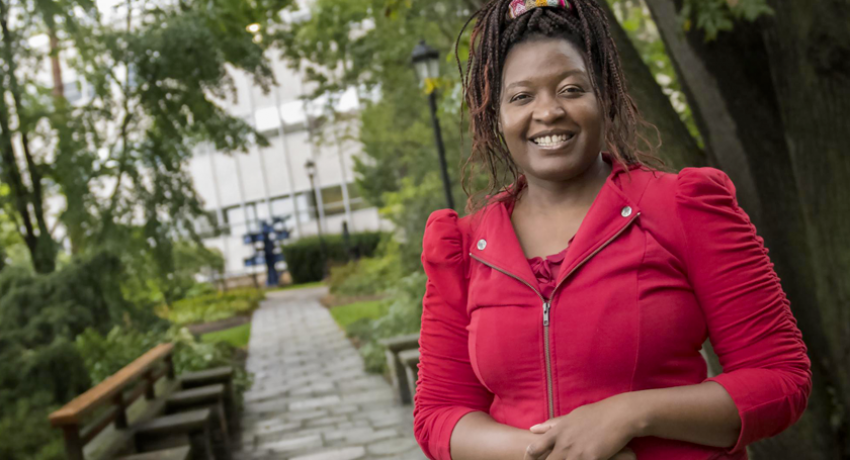Esther Obonyo, associate professor of engineering design and architectural engineering Credit: Patrick Mansell / Penn State.
By Samantha Chavanic
In 2015, all United Nations member states adopted the 2030 Agenda for Sustainable Development — a blueprint outlining 17 Sustainable Development Goals focused on peace and prosperity around the world.
Esther Obonyo, associate professor of engineering design and architectural engineering, leads the Global Building Network, an initiative of Penn State and the U.N. Economic Commission for Europe aimed at advancing building science, construction, and management to accomplish Sustainable Development Goal 11: Sustainable Cities and Communities. Obonyo also serves as the lead for a $1.1 million Belmont Forum-supported consortium working to improve resilient and sustainable housing in low-income communities impacted by climate change.
In this Q&A, Obonyo speaks with engineering writer Samantha Chavanic about working to improve resilient and sustainable housing in low-income communities impacted by climate change.
Q: What drew you to the built environment?
Obonyo: I was born and brought up in Nairobi, Kenya. Even though I’m from a middle-income family, I have lots of relatives who are in the lower social-economic status. From an early age, one of the things I was painfully aware of was the inadequate supply of quality housing for the masses. In these situations, you are not only looking at issues of building performance and technology, but also issues of economy. The transdisciplinary effort required to address this complex challenge of affordable, adequate housing drew me into feeling like this is a profession that can help me contribute.
Q: How does your joint appointment in engineering design and architectural engineering embody this cross-disciplinary effort?
Obonyo: To address the challenge of affordable, adequate housing holistically and comprehensively, you need transdisciplinary efforts. Coming to Penn State gave me an opportunity to explore synergies across multiple disciplines. I can maintain a grounding in engineering design and look at food insecurity as an aspect of adequate housing without losing credibility in the professional circles I move in, while concurrently exploring building performance aspects through my architectural engineering appointment.
Q: What is the Global Building Network undertaking in support of sustainable, safe buildings around the world?
Obonyo: The Global Building Network’s design allows synergies with universities and organizations to happen organically. It’s not competitive — it’s about being humble and saying, ‘we are great at what we do, but what we do is not going to get us there,’ in terms of supplying affordable, adequate, resilient, low-income housing and decarbonizing the building sector. Translating potential solutions into scalable impact requires several institutions working collaboratively. That’s what the Global Building Network is all about.
We have an opportunity to avoid potential problems through knowledge transfer. It is established fact that the bulk of new buildings will be constructed in the global south. We are worried that if the global south follows the trends of the global north, we will not achieve our targets for healthy, resilient, sustainable, low-income housing. We can also translate the lessons and experiences of the global south into strategies to use at scale in the global north, such as the use of locally resourced, low-carbon materials to inform material-related decarbonization efforts.
The final piece of the puzzle is related to human dignity and respect — housing is a basic human right. We’ve seen during the current pandemic that it’s at the center of our health, well-being, and performance.
Q: How will you and your collaborators use the Belmont funding to improve low-income communities?
Obonyo: A priority activity for me, at a personal level, is trying to engage with governmental and non-academic stakeholders. For me, step number one is making sure all stakeholders understand the value we create as academics. We’ve also prioritized gathering input from community members. The lived experiences of communities should inform every phase of the research process. Understanding and addressing the unique concerns and priorities for these different stakeholders requires input from multiple disciplines.
The question we are really trying to answer is ‘what causes vulnerability?’ We have failed community members by proposing one-dimensional solutions — we show up, we provide the walls, roof, windows, doors. Being adequately housed is more than the physical structure. In our research, we are redefining this with the help of social scientists, trying to find ways to connect with what the household members are asking for. Is it access to food, water, energy? All these still require a physical building. We can connect these needs to bankable projects policymakers can move and influence.
Q: What’s next?
Obonyo: At the workshops and research presentations I’ve attended over the years, we usually end up with this statement: ‘… but the government.” I would like the projects we are working on to have a different end, one where we say, ‘… and the government.’ That’s what’s next for me — getting to the point where our research moves policymaking.
This story first appeared in the Fall 2021 issue of Research|Penn State magazine.
Read the full news story here:
https://www.psu.edu/news/story/touch-esther-obonyo-building-sustainable-safe-...

